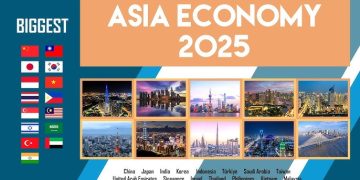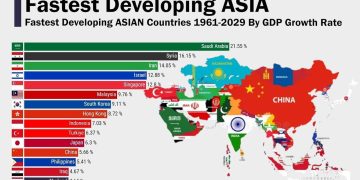1. Introduction: A Labor Market in Transition
As the United States moves further into 2025, its labor market exhibits a complex mix of resilience, strain, and transformation. Headlines of low unemployment—hovering around 3.8%—suggest strength, yet a deeper analysis reveals underlying shifts: productivity growth stagnation, wage pressures, skill mismatches, and the structural effects of automation and artificial intelligence.
For policymakers, business leaders, and investors, understanding these dynamics is crucial. Labor is not just an economic variable—it is the engine that drives consumption, investment, and long-term growth. This article explores the evolving landscape of U.S. labor markets, examining wages, productivity, structural changes, demographic factors, and policy implications.
2. Employment Strength Amid Stagnation
The post-pandemic labor market recovery has been remarkably strong. Total nonfarm employment has recovered to pre-pandemic levels, and sectors like technology, healthcare, and professional services continue to grow.
Yet, beneath headline unemployment figures lies a more nuanced story:
- Labor Force Participation: While improving, the participation rate remains below pre-pandemic norms, particularly among prime-age workers (25–54).
- Sectoral Shifts: Traditional manufacturing and administrative jobs have plateaued or declined, while knowledge-intensive and service sectors expand.
- Geographic Imbalances: Regional disparities persist, with some rural and rust-belt areas lagging behind urban hubs in job creation and wage growth.
This duality—strong employment yet uneven recovery—illustrates the structural transformations reshaping the American labor market.
3. Wage Dynamics: Gains and Pressures
Wage growth in the United States has been a central concern for both economists and policymakers. In 2025, average hourly earnings are rising at approximately 4–5% year-on-year, reflecting competition for talent in high-demand sectors.
Key factors influencing wage dynamics include:
- Skill Shortages: Technology, healthcare, and logistics sectors face acute talent shortages, driving wages higher.
- Inflationary Pressure: Persistent core inflation has eroded real wage gains, particularly affecting lower-income households.
- Union Influence: Recent labor strikes in manufacturing and transport highlight renewed collective bargaining, affecting wage settlements and signaling a shift in worker leverage.
Despite these gains, productivity growth has not kept pace with wage increases, creating concerns about cost pressures for businesses and potential inflationary feedback.
4. Productivity Paradox
The United States faces a persistent productivity paradox: strong employment growth without commensurate gains in output per hour. This stagnation has implications for competitiveness and real wage sustainability.
Drivers of this trend include:
- Technology Adoption Lag: While AI and automation are expanding, integration into core business processes remains uneven.
- Sectoral Composition: Growth in low-productivity services (retail, hospitality) offsets gains in high-productivity tech sectors.
- Capital Constraints: Firms are cautious in capital investments amid interest rate pressures, limiting productivity-enhancing tools and infrastructure.
Addressing this paradox is essential for maintaining wage growth without stoking inflation.
5. Structural Changes: Automation, AI, and Skill Shifts
Automation and AI adoption are redefining employment. Routine tasks in administration, manufacturing, and logistics are increasingly automated, while demand rises for digital, analytical, and creative skills.
Implications include:
- Skill Mismatches: Workers displaced from traditional roles often lack qualifications for emerging sectors, increasing friction in labor markets.
- Training and Reskilling: Federal and state initiatives aim to upskill the workforce, but implementation lags behind demand.
- Geographic Polarization: Cities with strong tech ecosystems benefit, while rural and mid-sized regions face slower adaptation.
The labor market is therefore bifurcating: high-skill, high-productivity jobs grow, while low-skill roles face stagnation or displacement.
6. Demographics and Participation
Demographic factors play a critical role:
- Aging Workforce: Baby Boomers continue to retire, reducing labor supply and increasing demand for younger workers.
- Immigration: Policy uncertainty limits the inflow of international talent, affecting sectors like agriculture, technology, and healthcare.
- Diversity and Inclusion: Efforts to increase participation among women, minorities, and underrepresented groups influence labor force composition and long-term growth potential.
Demographic trends intersect with structural and technological shifts, amplifying labor market complexity.

7. Regional Disparities and Inequality
Labor market outcomes vary significantly by region:
- Urban Tech Hubs: High wages, low unemployment, and skill concentration drive productivity and innovation.
- Rust Belt and Rural Areas: Limited investment, declining industries, and slower skill adaptation contribute to persistent unemployment and wage stagnation.
- Sun Belt Growth: Migration to the South and Southwest fuels labor supply but also strains housing and infrastructure.
These disparities underscore the uneven nature of economic recovery and investment potential.
8. Policy Responses and Labor Market Resilience
Policymakers face a delicate challenge:
- Monetary Policy: The Federal Reserve’s interest rate decisions affect investment and hiring, particularly in capital-intensive sectors.
- Fiscal Policy: Infrastructure bills, R&D incentives, and workforce development programs aim to enhance employment quality and productivity.
- Labor Regulations: Minimum wage adjustments, union protections, and labor mobility reforms shape both wages and employment participation.
A coordinated approach is essential to balance inflation control with growth and inclusivity.
9. Emerging Trends in Work and Employment
New work patterns are reshaping the labor market:
- Hybrid Work: Remote and flexible arrangements persist, affecting urban real estate, commuting patterns, and local economies.
- Gig Economy: Short-term, freelance, and platform-based work continues to expand, providing flexibility but raising questions about benefits and job security.
- Corporate Adaptation: Companies invest in employee engagement, skill development, and retention strategies to compete for talent in a tight market.
These trends redefine labor relations and productivity dynamics in the U.S.
10. Conclusion: Navigating Uncertainty and Opportunity
The U.S. labor market in 2025 is a story of contrasts:
- Resilience in employment and wages
- Stagnation in productivity and skill alignment
- Regional and sectoral disparities
- Technological disruption and demographic shifts
For businesses, investors, and policymakers, the challenge is to foster a labor market that supports sustainable growth. Strategic investment in skills, technology, and infrastructure will determine whether the U.S. can maintain its economic momentum amidst uncertainty.
Ultimately, labor market adaptability, combined with smart policy, remains the key to enduring economic strength.






































